Applied Corporate Strategy: Tesla's Strategic Analysis Report
VerifiedAdded on 2022/09/09
|13
|4462
|48
Report
AI Summary
This report provides a comprehensive strategic analysis of Tesla, the electric vehicle and clean energy company. It begins with an external analysis, identifying opportunities such as government subsidies for green energy and the potential of self-driving technology, alongside threats like competition from established automakers and the high cost of Tesla vehicles. The report then delves into industry analysis, examining competitive rivalry, the bargaining power of buyers and suppliers, the threat of substitutes, and the threat of new entrants. Key resources and competencies are evaluated, highlighting Tesla's human capital, CEO Elon Musk's influence, and technological innovations. The report identifies core competencies, including Tesla's leadership in the electric vehicle market and its high innovation rate. The link between unique capabilities and competitive advantage is explored, emphasizing Tesla's clean energy products, technological advancements, and difficult-to-imitate strategies, ultimately contributing to its sustainable competitive advantage. Finally, the report evaluates a recent strategy implemented by Tesla, assessing its effectiveness using SAFe criteria.
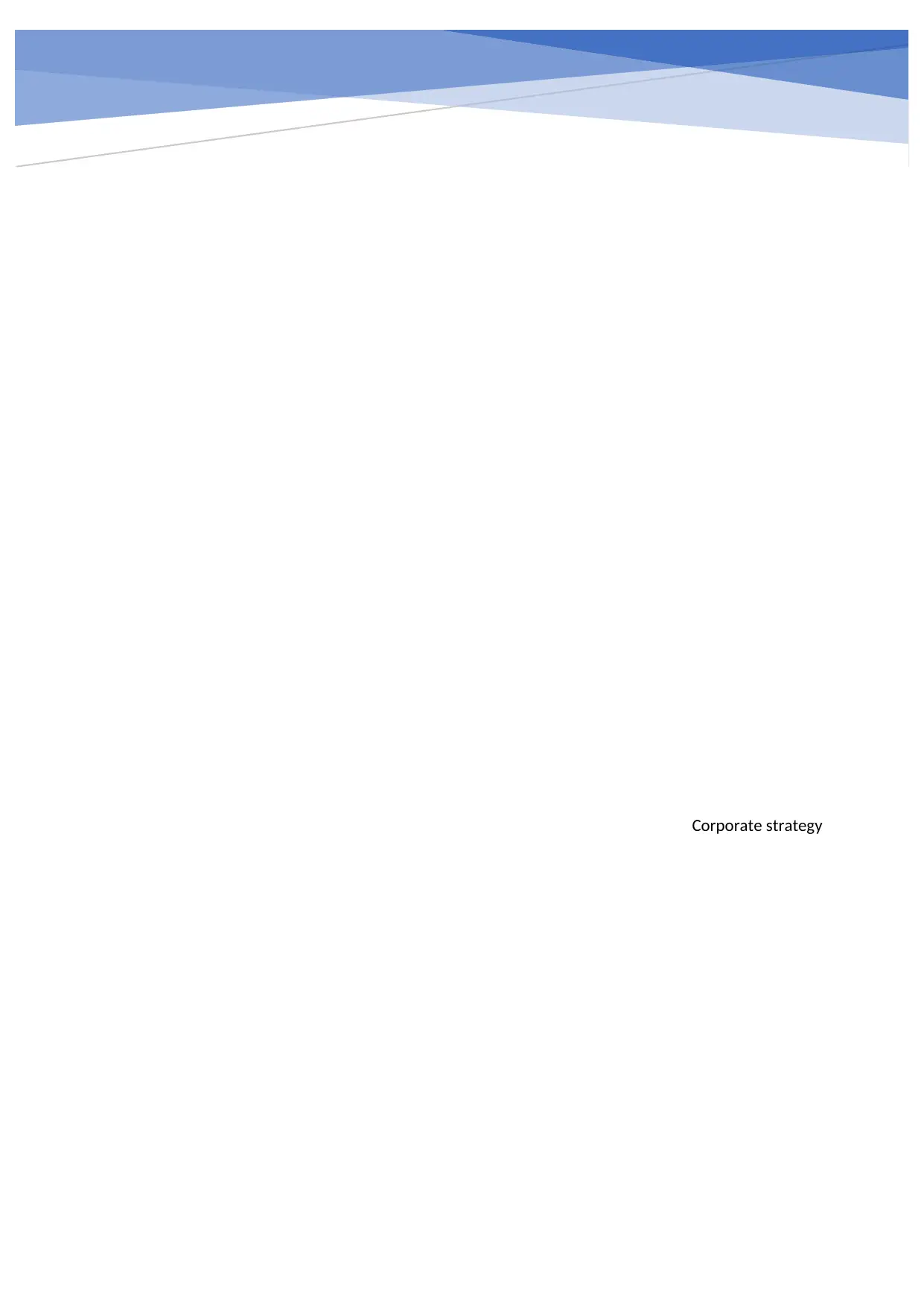
Corporate strategy
Paraphrase This Document
Need a fresh take? Get an instant paraphrase of this document with our AI Paraphraser
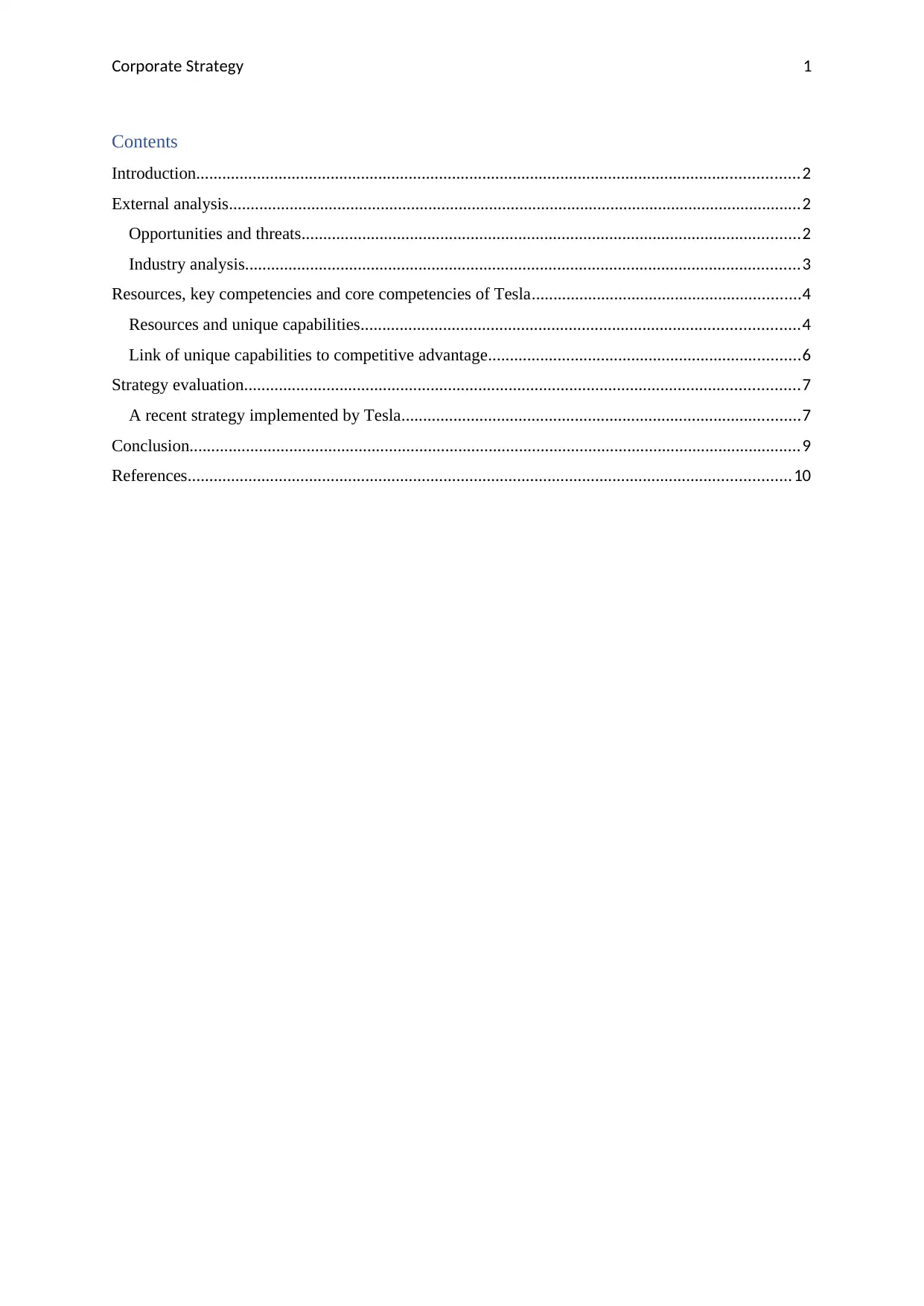
Corporate Strategy 1
Contents
Introduction...........................................................................................................................................2
External analysis....................................................................................................................................2
Opportunities and threats...................................................................................................................2
Industry analysis................................................................................................................................3
Resources, key competencies and core competencies of Tesla..............................................................4
Resources and unique capabilities.....................................................................................................4
Link of unique capabilities to competitive advantage........................................................................6
Strategy evaluation................................................................................................................................7
A recent strategy implemented by Tesla............................................................................................7
Conclusion.............................................................................................................................................9
References...........................................................................................................................................10
Contents
Introduction...........................................................................................................................................2
External analysis....................................................................................................................................2
Opportunities and threats...................................................................................................................2
Industry analysis................................................................................................................................3
Resources, key competencies and core competencies of Tesla..............................................................4
Resources and unique capabilities.....................................................................................................4
Link of unique capabilities to competitive advantage........................................................................6
Strategy evaluation................................................................................................................................7
A recent strategy implemented by Tesla............................................................................................7
Conclusion.............................................................................................................................................9
References...........................................................................................................................................10
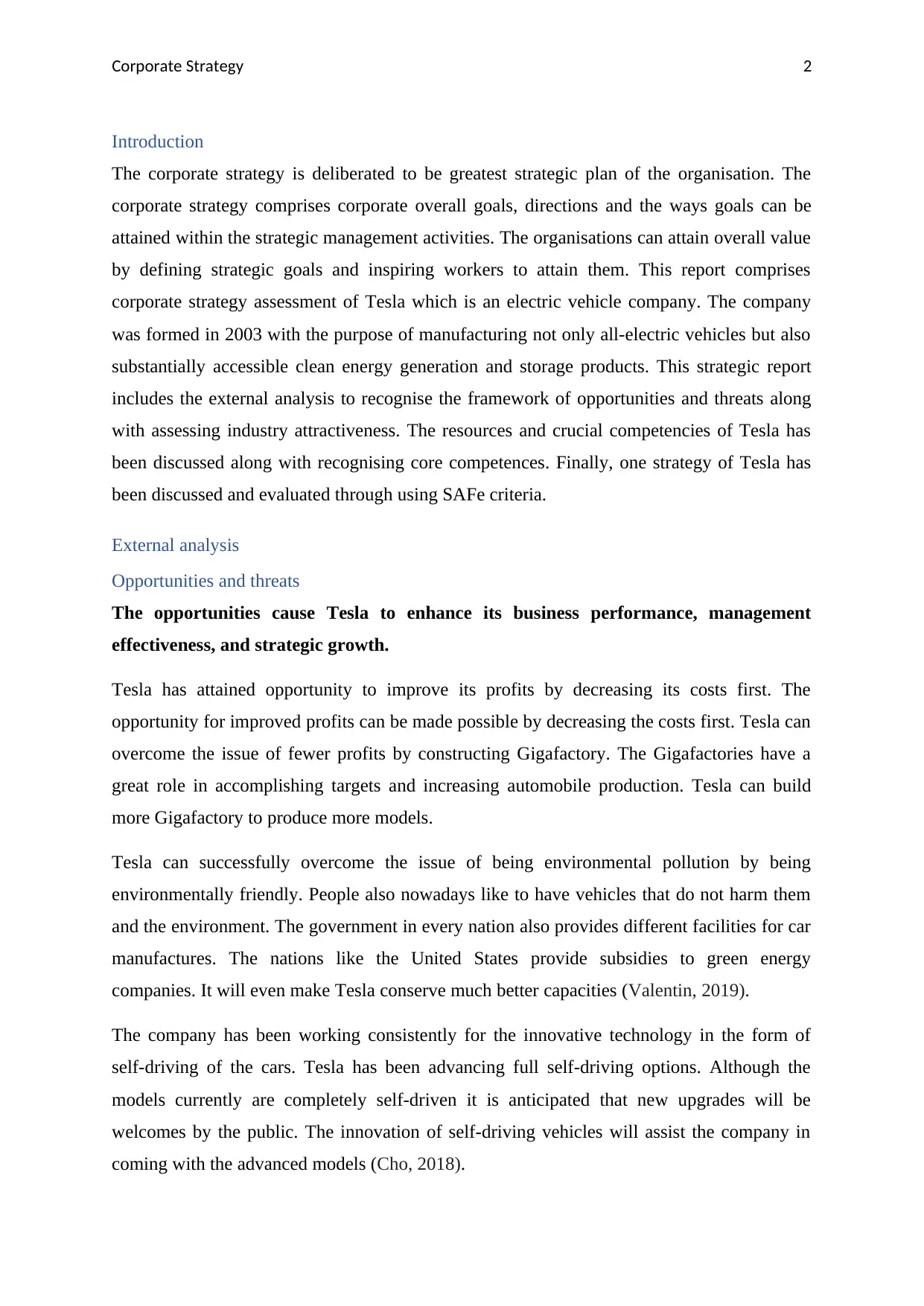
Corporate Strategy 2
Introduction
The corporate strategy is deliberated to be greatest strategic plan of the organisation. The
corporate strategy comprises corporate overall goals, directions and the ways goals can be
attained within the strategic management activities. The organisations can attain overall value
by defining strategic goals and inspiring workers to attain them. This report comprises
corporate strategy assessment of Tesla which is an electric vehicle company. The company
was formed in 2003 with the purpose of manufacturing not only all-electric vehicles but also
substantially accessible clean energy generation and storage products. This strategic report
includes the external analysis to recognise the framework of opportunities and threats along
with assessing industry attractiveness. The resources and crucial competencies of Tesla has
been discussed along with recognising core competences. Finally, one strategy of Tesla has
been discussed and evaluated through using SAFe criteria.
External analysis
Opportunities and threats
The opportunities cause Tesla to enhance its business performance, management
effectiveness, and strategic growth.
Tesla has attained opportunity to improve its profits by decreasing its costs first. The
opportunity for improved profits can be made possible by decreasing the costs first. Tesla can
overcome the issue of fewer profits by constructing Gigafactory. The Gigafactories have a
great role in accomplishing targets and increasing automobile production. Tesla can build
more Gigafactory to produce more models.
Tesla can successfully overcome the issue of being environmental pollution by being
environmentally friendly. People also nowadays like to have vehicles that do not harm them
and the environment. The government in every nation also provides different facilities for car
manufactures. The nations like the United States provide subsidies to green energy
companies. It will even make Tesla conserve much better capacities (Valentin, 2019).
The company has been working consistently for the innovative technology in the form of
self-driving of the cars. Tesla has been advancing full self-driving options. Although the
models currently are completely self-driven it is anticipated that new upgrades will be
welcomes by the public. The innovation of self-driving vehicles will assist the company in
coming with the advanced models (Cho, 2018).
Introduction
The corporate strategy is deliberated to be greatest strategic plan of the organisation. The
corporate strategy comprises corporate overall goals, directions and the ways goals can be
attained within the strategic management activities. The organisations can attain overall value
by defining strategic goals and inspiring workers to attain them. This report comprises
corporate strategy assessment of Tesla which is an electric vehicle company. The company
was formed in 2003 with the purpose of manufacturing not only all-electric vehicles but also
substantially accessible clean energy generation and storage products. This strategic report
includes the external analysis to recognise the framework of opportunities and threats along
with assessing industry attractiveness. The resources and crucial competencies of Tesla has
been discussed along with recognising core competences. Finally, one strategy of Tesla has
been discussed and evaluated through using SAFe criteria.
External analysis
Opportunities and threats
The opportunities cause Tesla to enhance its business performance, management
effectiveness, and strategic growth.
Tesla has attained opportunity to improve its profits by decreasing its costs first. The
opportunity for improved profits can be made possible by decreasing the costs first. Tesla can
overcome the issue of fewer profits by constructing Gigafactory. The Gigafactories have a
great role in accomplishing targets and increasing automobile production. Tesla can build
more Gigafactory to produce more models.
Tesla can successfully overcome the issue of being environmental pollution by being
environmentally friendly. People also nowadays like to have vehicles that do not harm them
and the environment. The government in every nation also provides different facilities for car
manufactures. The nations like the United States provide subsidies to green energy
companies. It will even make Tesla conserve much better capacities (Valentin, 2019).
The company has been working consistently for the innovative technology in the form of
self-driving of the cars. Tesla has been advancing full self-driving options. Although the
models currently are completely self-driven it is anticipated that new upgrades will be
welcomes by the public. The innovation of self-driving vehicles will assist the company in
coming with the advanced models (Cho, 2018).
⊘ This is a preview!⊘
Do you want full access?
Subscribe today to unlock all pages.

Trusted by 1+ million students worldwide
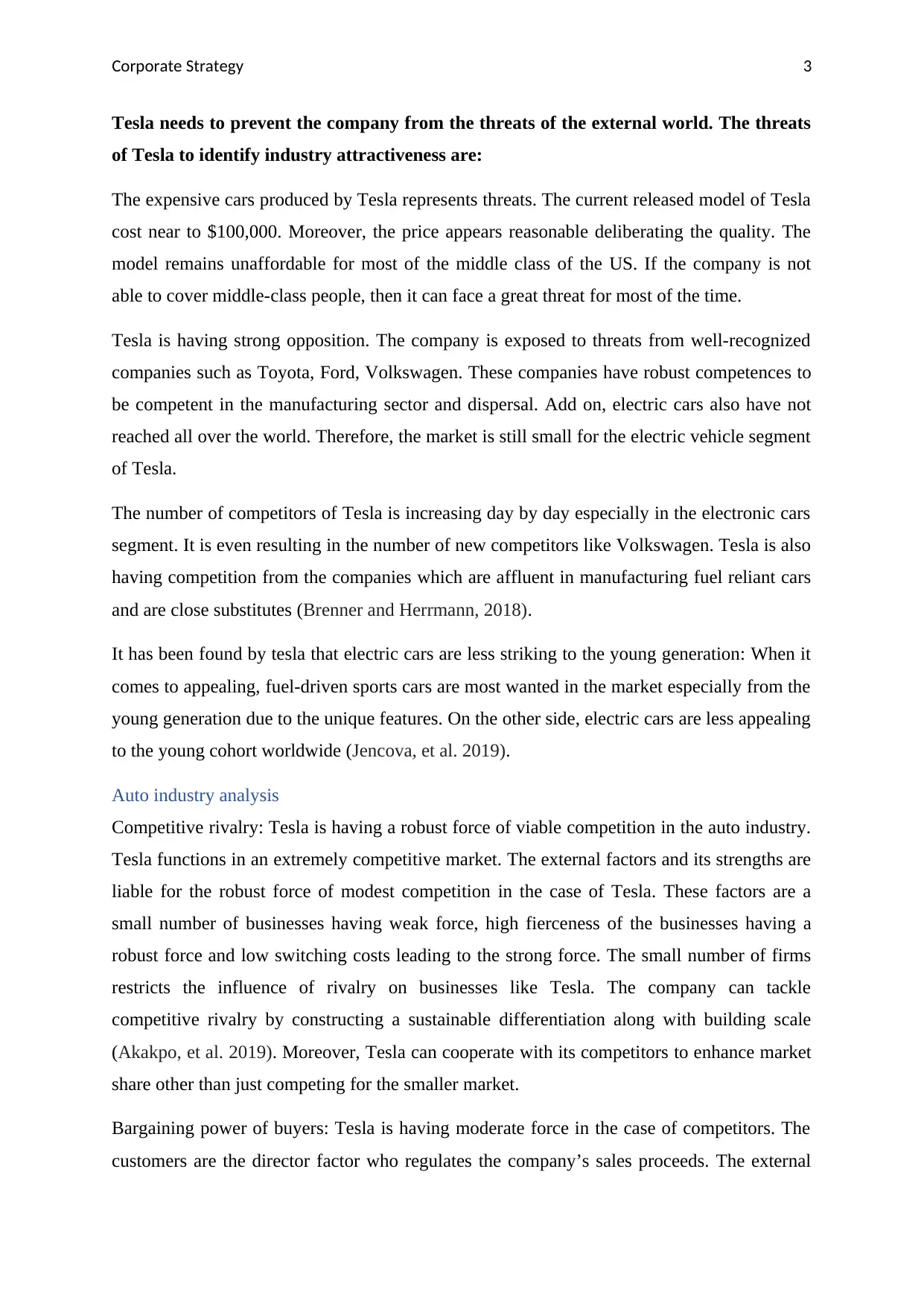
Corporate Strategy 3
Tesla needs to prevent the company from the threats of the external world. The threats
of Tesla to identify industry attractiveness are:
The expensive cars produced by Tesla represents threats. The current released model of Tesla
cost near to $100,000. Moreover, the price appears reasonable deliberating the quality. The
model remains unaffordable for most of the middle class of the US. If the company is not
able to cover middle-class people, then it can face a great threat for most of the time.
Tesla is having strong opposition. The company is exposed to threats from well-recognized
companies such as Toyota, Ford, Volkswagen. These companies have robust competences to
be competent in the manufacturing sector and dispersal. Add on, electric cars also have not
reached all over the world. Therefore, the market is still small for the electric vehicle segment
of Tesla.
The number of competitors of Tesla is increasing day by day especially in the electronic cars
segment. It is even resulting in the number of new competitors like Volkswagen. Tesla is also
having competition from the companies which are affluent in manufacturing fuel reliant cars
and are close substitutes (Brenner and Herrmann, 2018).
It has been found by tesla that electric cars are less striking to the young generation: When it
comes to appealing, fuel-driven sports cars are most wanted in the market especially from the
young generation due to the unique features. On the other side, electric cars are less appealing
to the young cohort worldwide (Jencova, et al. 2019).
Auto industry analysis
Competitive rivalry: Tesla is having a robust force of viable competition in the auto industry.
Tesla functions in an extremely competitive market. The external factors and its strengths are
liable for the robust force of modest competition in the case of Tesla. These factors are a
small number of businesses having weak force, high fierceness of the businesses having a
robust force and low switching costs leading to the strong force. The small number of firms
restricts the influence of rivalry on businesses like Tesla. The company can tackle
competitive rivalry by constructing a sustainable differentiation along with building scale
(Akakpo, et al. 2019). Moreover, Tesla can cooperate with its competitors to enhance market
share other than just competing for the smaller market.
Bargaining power of buyers: Tesla is having moderate force in the case of competitors. The
customers are the director factor who regulates the company’s sales proceeds. The external
Tesla needs to prevent the company from the threats of the external world. The threats
of Tesla to identify industry attractiveness are:
The expensive cars produced by Tesla represents threats. The current released model of Tesla
cost near to $100,000. Moreover, the price appears reasonable deliberating the quality. The
model remains unaffordable for most of the middle class of the US. If the company is not
able to cover middle-class people, then it can face a great threat for most of the time.
Tesla is having strong opposition. The company is exposed to threats from well-recognized
companies such as Toyota, Ford, Volkswagen. These companies have robust competences to
be competent in the manufacturing sector and dispersal. Add on, electric cars also have not
reached all over the world. Therefore, the market is still small for the electric vehicle segment
of Tesla.
The number of competitors of Tesla is increasing day by day especially in the electronic cars
segment. It is even resulting in the number of new competitors like Volkswagen. Tesla is also
having competition from the companies which are affluent in manufacturing fuel reliant cars
and are close substitutes (Brenner and Herrmann, 2018).
It has been found by tesla that electric cars are less striking to the young generation: When it
comes to appealing, fuel-driven sports cars are most wanted in the market especially from the
young generation due to the unique features. On the other side, electric cars are less appealing
to the young cohort worldwide (Jencova, et al. 2019).
Auto industry analysis
Competitive rivalry: Tesla is having a robust force of viable competition in the auto industry.
Tesla functions in an extremely competitive market. The external factors and its strengths are
liable for the robust force of modest competition in the case of Tesla. These factors are a
small number of businesses having weak force, high fierceness of the businesses having a
robust force and low switching costs leading to the strong force. The small number of firms
restricts the influence of rivalry on businesses like Tesla. The company can tackle
competitive rivalry by constructing a sustainable differentiation along with building scale
(Akakpo, et al. 2019). Moreover, Tesla can cooperate with its competitors to enhance market
share other than just competing for the smaller market.
Bargaining power of buyers: Tesla is having moderate force in the case of competitors. The
customers are the director factor who regulates the company’s sales proceeds. The external
Paraphrase This Document
Need a fresh take? Get an instant paraphrase of this document with our AI Paraphraser
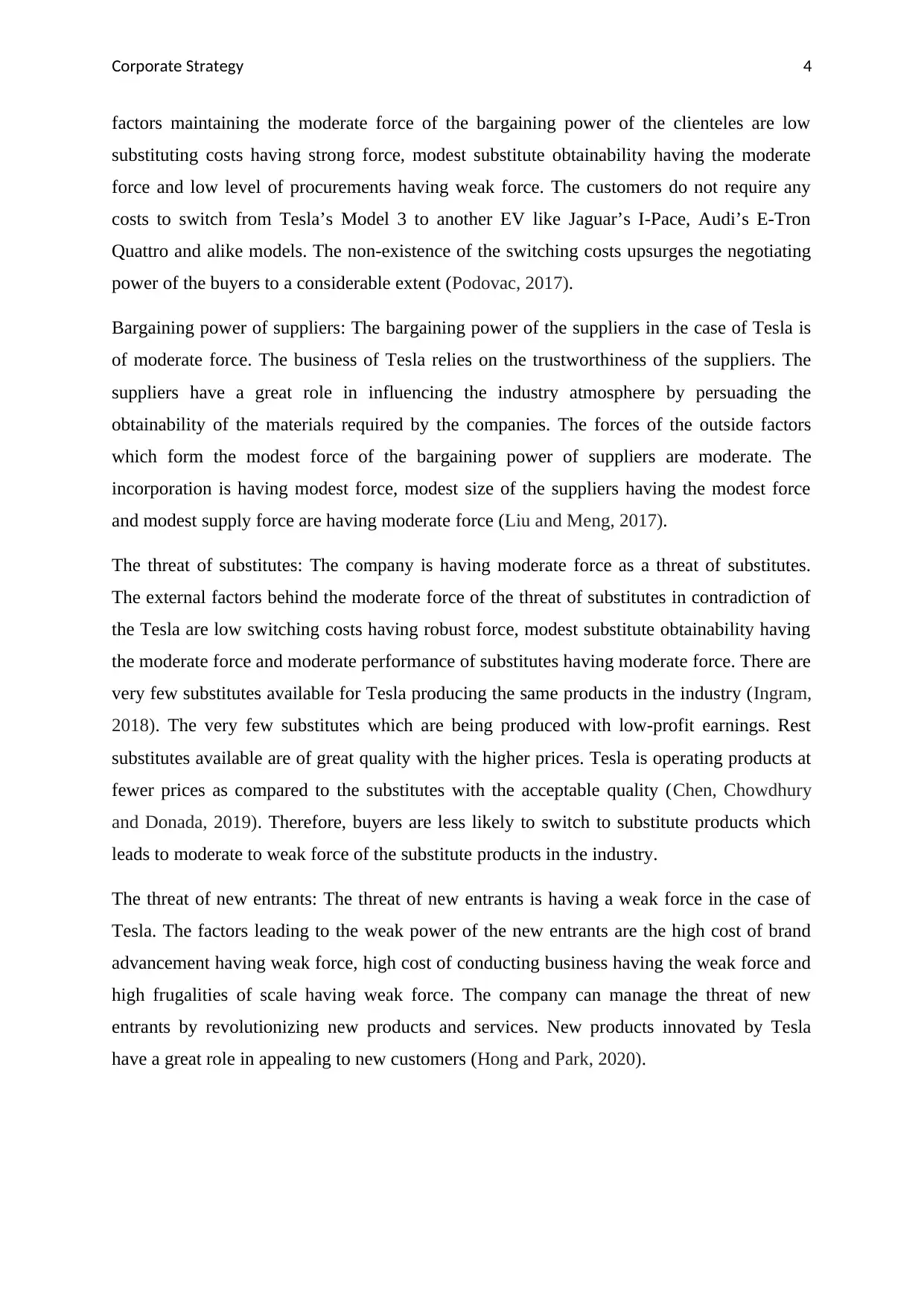
Corporate Strategy 4
factors maintaining the moderate force of the bargaining power of the clienteles are low
substituting costs having strong force, modest substitute obtainability having the moderate
force and low level of procurements having weak force. The customers do not require any
costs to switch from Tesla’s Model 3 to another EV like Jaguar’s I-Pace, Audi’s E-Tron
Quattro and alike models. The non-existence of the switching costs upsurges the negotiating
power of the buyers to a considerable extent (Podovac, 2017).
Bargaining power of suppliers: The bargaining power of the suppliers in the case of Tesla is
of moderate force. The business of Tesla relies on the trustworthiness of the suppliers. The
suppliers have a great role in influencing the industry atmosphere by persuading the
obtainability of the materials required by the companies. The forces of the outside factors
which form the modest force of the bargaining power of suppliers are moderate. The
incorporation is having modest force, modest size of the suppliers having the modest force
and modest supply force are having moderate force (Liu and Meng, 2017).
The threat of substitutes: The company is having moderate force as a threat of substitutes.
The external factors behind the moderate force of the threat of substitutes in contradiction of
the Tesla are low switching costs having robust force, modest substitute obtainability having
the moderate force and moderate performance of substitutes having moderate force. There are
very few substitutes available for Tesla producing the same products in the industry (Ingram,
2018). The very few substitutes which are being produced with low-profit earnings. Rest
substitutes available are of great quality with the higher prices. Tesla is operating products at
fewer prices as compared to the substitutes with the acceptable quality (Chen, Chowdhury
and Donada, 2019). Therefore, buyers are less likely to switch to substitute products which
leads to moderate to weak force of the substitute products in the industry.
The threat of new entrants: The threat of new entrants is having a weak force in the case of
Tesla. The factors leading to the weak power of the new entrants are the high cost of brand
advancement having weak force, high cost of conducting business having the weak force and
high frugalities of scale having weak force. The company can manage the threat of new
entrants by revolutionizing new products and services. New products innovated by Tesla
have a great role in appealing to new customers (Hong and Park, 2020).
factors maintaining the moderate force of the bargaining power of the clienteles are low
substituting costs having strong force, modest substitute obtainability having the moderate
force and low level of procurements having weak force. The customers do not require any
costs to switch from Tesla’s Model 3 to another EV like Jaguar’s I-Pace, Audi’s E-Tron
Quattro and alike models. The non-existence of the switching costs upsurges the negotiating
power of the buyers to a considerable extent (Podovac, 2017).
Bargaining power of suppliers: The bargaining power of the suppliers in the case of Tesla is
of moderate force. The business of Tesla relies on the trustworthiness of the suppliers. The
suppliers have a great role in influencing the industry atmosphere by persuading the
obtainability of the materials required by the companies. The forces of the outside factors
which form the modest force of the bargaining power of suppliers are moderate. The
incorporation is having modest force, modest size of the suppliers having the modest force
and modest supply force are having moderate force (Liu and Meng, 2017).
The threat of substitutes: The company is having moderate force as a threat of substitutes.
The external factors behind the moderate force of the threat of substitutes in contradiction of
the Tesla are low switching costs having robust force, modest substitute obtainability having
the moderate force and moderate performance of substitutes having moderate force. There are
very few substitutes available for Tesla producing the same products in the industry (Ingram,
2018). The very few substitutes which are being produced with low-profit earnings. Rest
substitutes available are of great quality with the higher prices. Tesla is operating products at
fewer prices as compared to the substitutes with the acceptable quality (Chen, Chowdhury
and Donada, 2019). Therefore, buyers are less likely to switch to substitute products which
leads to moderate to weak force of the substitute products in the industry.
The threat of new entrants: The threat of new entrants is having a weak force in the case of
Tesla. The factors leading to the weak power of the new entrants are the high cost of brand
advancement having weak force, high cost of conducting business having the weak force and
high frugalities of scale having weak force. The company can manage the threat of new
entrants by revolutionizing new products and services. New products innovated by Tesla
have a great role in appealing to new customers (Hong and Park, 2020).
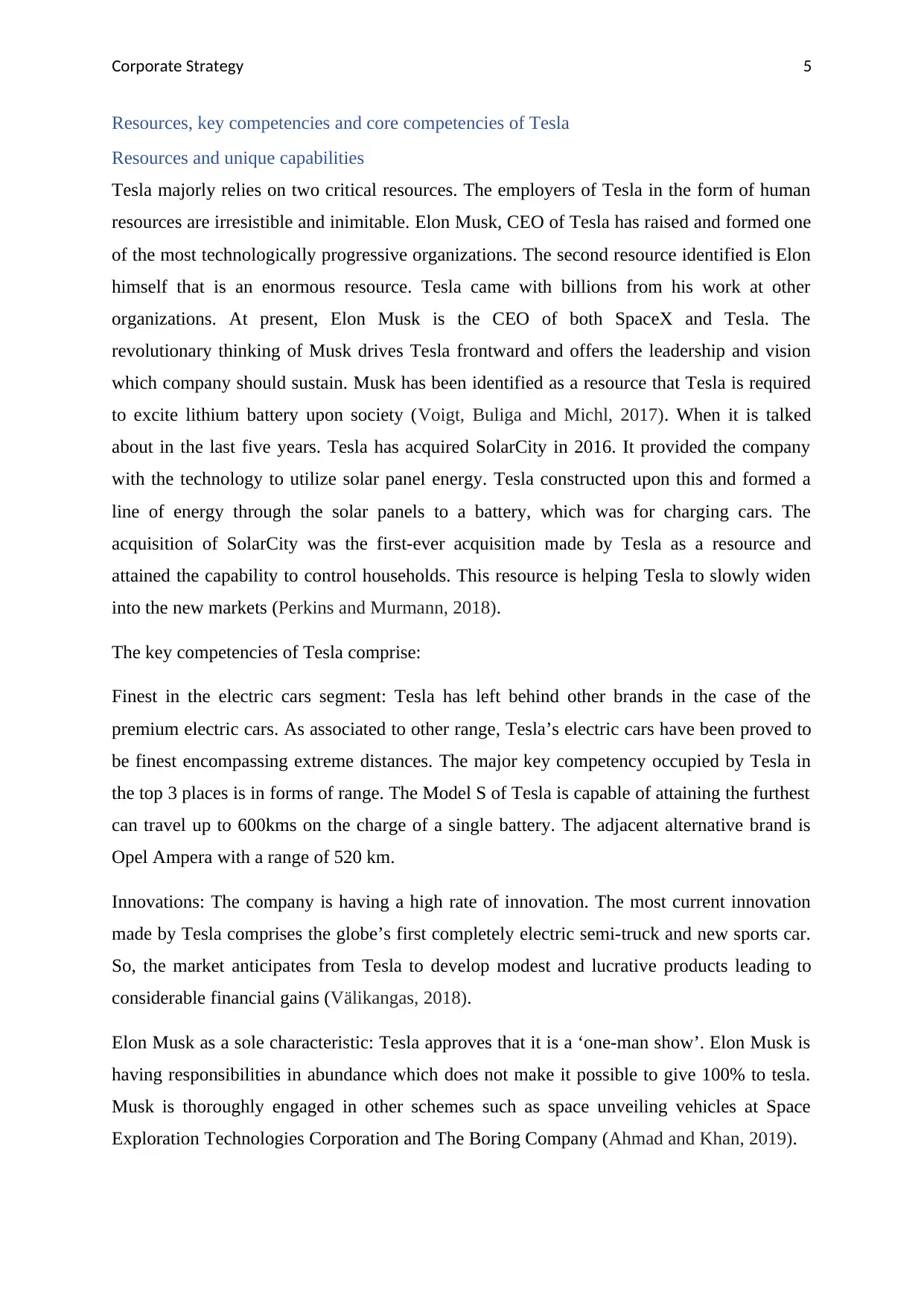
Corporate Strategy 5
Resources, key competencies and core competencies of Tesla
Resources and unique capabilities
Tesla majorly relies on two critical resources. The employers of Tesla in the form of human
resources are irresistible and inimitable. Elon Musk, CEO of Tesla has raised and formed one
of the most technologically progressive organizations. The second resource identified is Elon
himself that is an enormous resource. Tesla came with billions from his work at other
organizations. At present, Elon Musk is the CEO of both SpaceX and Tesla. The
revolutionary thinking of Musk drives Tesla frontward and offers the leadership and vision
which company should sustain. Musk has been identified as a resource that Tesla is required
to excite lithium battery upon society (Voigt, Buliga and Michl, 2017). When it is talked
about in the last five years. Tesla has acquired SolarCity in 2016. It provided the company
with the technology to utilize solar panel energy. Tesla constructed upon this and formed a
line of energy through the solar panels to a battery, which was for charging cars. The
acquisition of SolarCity was the first-ever acquisition made by Tesla as a resource and
attained the capability to control households. This resource is helping Tesla to slowly widen
into the new markets (Perkins and Murmann, 2018).
The key competencies of Tesla comprise:
Finest in the electric cars segment: Tesla has left behind other brands in the case of the
premium electric cars. As associated to other range, Tesla’s electric cars have been proved to
be finest encompassing extreme distances. The major key competency occupied by Tesla in
the top 3 places is in forms of range. The Model S of Tesla is capable of attaining the furthest
can travel up to 600kms on the charge of a single battery. The adjacent alternative brand is
Opel Ampera with a range of 520 km.
Innovations: The company is having a high rate of innovation. The most current innovation
made by Tesla comprises the globe’s first completely electric semi-truck and new sports car.
So, the market anticipates from Tesla to develop modest and lucrative products leading to
considerable financial gains (Välikangas, 2018).
Elon Musk as a sole characteristic: Tesla approves that it is a ‘one-man show’. Elon Musk is
having responsibilities in abundance which does not make it possible to give 100% to tesla.
Musk is thoroughly engaged in other schemes such as space unveiling vehicles at Space
Exploration Technologies Corporation and The Boring Company (Ahmad and Khan, 2019).
Resources, key competencies and core competencies of Tesla
Resources and unique capabilities
Tesla majorly relies on two critical resources. The employers of Tesla in the form of human
resources are irresistible and inimitable. Elon Musk, CEO of Tesla has raised and formed one
of the most technologically progressive organizations. The second resource identified is Elon
himself that is an enormous resource. Tesla came with billions from his work at other
organizations. At present, Elon Musk is the CEO of both SpaceX and Tesla. The
revolutionary thinking of Musk drives Tesla frontward and offers the leadership and vision
which company should sustain. Musk has been identified as a resource that Tesla is required
to excite lithium battery upon society (Voigt, Buliga and Michl, 2017). When it is talked
about in the last five years. Tesla has acquired SolarCity in 2016. It provided the company
with the technology to utilize solar panel energy. Tesla constructed upon this and formed a
line of energy through the solar panels to a battery, which was for charging cars. The
acquisition of SolarCity was the first-ever acquisition made by Tesla as a resource and
attained the capability to control households. This resource is helping Tesla to slowly widen
into the new markets (Perkins and Murmann, 2018).
The key competencies of Tesla comprise:
Finest in the electric cars segment: Tesla has left behind other brands in the case of the
premium electric cars. As associated to other range, Tesla’s electric cars have been proved to
be finest encompassing extreme distances. The major key competency occupied by Tesla in
the top 3 places is in forms of range. The Model S of Tesla is capable of attaining the furthest
can travel up to 600kms on the charge of a single battery. The adjacent alternative brand is
Opel Ampera with a range of 520 km.
Innovations: The company is having a high rate of innovation. The most current innovation
made by Tesla comprises the globe’s first completely electric semi-truck and new sports car.
So, the market anticipates from Tesla to develop modest and lucrative products leading to
considerable financial gains (Välikangas, 2018).
Elon Musk as a sole characteristic: Tesla approves that it is a ‘one-man show’. Elon Musk is
having responsibilities in abundance which does not make it possible to give 100% to tesla.
Musk is thoroughly engaged in other schemes such as space unveiling vehicles at Space
Exploration Technologies Corporation and The Boring Company (Ahmad and Khan, 2019).
⊘ This is a preview!⊘
Do you want full access?
Subscribe today to unlock all pages.

Trusted by 1+ million students worldwide
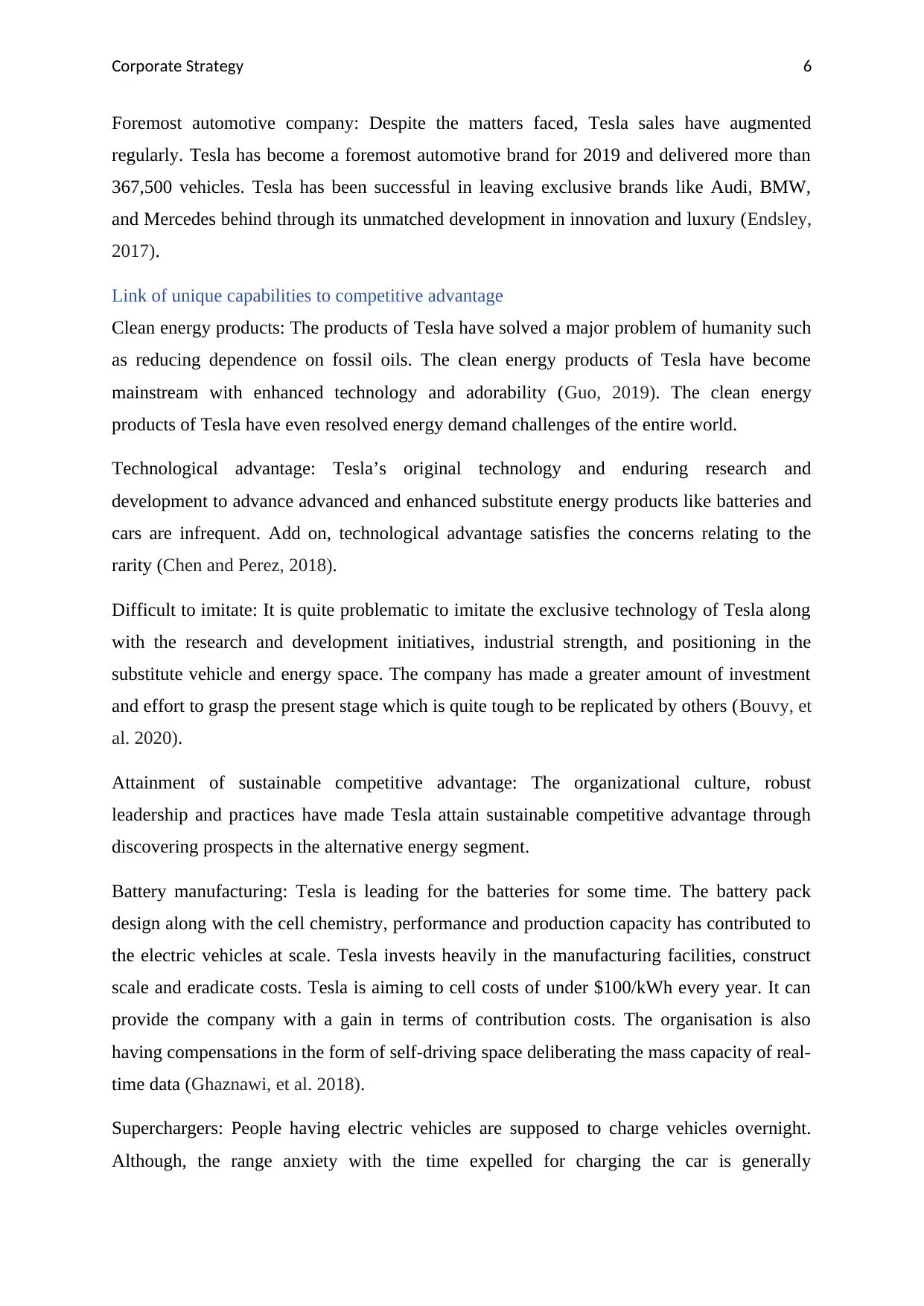
Corporate Strategy 6
Foremost automotive company: Despite the matters faced, Tesla sales have augmented
regularly. Tesla has become a foremost automotive brand for 2019 and delivered more than
367,500 vehicles. Tesla has been successful in leaving exclusive brands like Audi, BMW,
and Mercedes behind through its unmatched development in innovation and luxury (Endsley,
2017).
Link of unique capabilities to competitive advantage
Clean energy products: The products of Tesla have solved a major problem of humanity such
as reducing dependence on fossil oils. The clean energy products of Tesla have become
mainstream with enhanced technology and adorability (Guo, 2019). The clean energy
products of Tesla have even resolved energy demand challenges of the entire world.
Technological advantage: Tesla’s original technology and enduring research and
development to advance advanced and enhanced substitute energy products like batteries and
cars are infrequent. Add on, technological advantage satisfies the concerns relating to the
rarity (Chen and Perez, 2018).
Difficult to imitate: It is quite problematic to imitate the exclusive technology of Tesla along
with the research and development initiatives, industrial strength, and positioning in the
substitute vehicle and energy space. The company has made a greater amount of investment
and effort to grasp the present stage which is quite tough to be replicated by others (Bouvy, et
al. 2020).
Attainment of sustainable competitive advantage: The organizational culture, robust
leadership and practices have made Tesla attain sustainable competitive advantage through
discovering prospects in the alternative energy segment.
Battery manufacturing: Tesla is leading for the batteries for some time. The battery pack
design along with the cell chemistry, performance and production capacity has contributed to
the electric vehicles at scale. Tesla invests heavily in the manufacturing facilities, construct
scale and eradicate costs. Tesla is aiming to cell costs of under $100/kWh every year. It can
provide the company with a gain in terms of contribution costs. The organisation is also
having compensations in the form of self-driving space deliberating the mass capacity of real-
time data (Ghaznawi, et al. 2018).
Superchargers: People having electric vehicles are supposed to charge vehicles overnight.
Although, the range anxiety with the time expelled for charging the car is generally
Foremost automotive company: Despite the matters faced, Tesla sales have augmented
regularly. Tesla has become a foremost automotive brand for 2019 and delivered more than
367,500 vehicles. Tesla has been successful in leaving exclusive brands like Audi, BMW,
and Mercedes behind through its unmatched development in innovation and luxury (Endsley,
2017).
Link of unique capabilities to competitive advantage
Clean energy products: The products of Tesla have solved a major problem of humanity such
as reducing dependence on fossil oils. The clean energy products of Tesla have become
mainstream with enhanced technology and adorability (Guo, 2019). The clean energy
products of Tesla have even resolved energy demand challenges of the entire world.
Technological advantage: Tesla’s original technology and enduring research and
development to advance advanced and enhanced substitute energy products like batteries and
cars are infrequent. Add on, technological advantage satisfies the concerns relating to the
rarity (Chen and Perez, 2018).
Difficult to imitate: It is quite problematic to imitate the exclusive technology of Tesla along
with the research and development initiatives, industrial strength, and positioning in the
substitute vehicle and energy space. The company has made a greater amount of investment
and effort to grasp the present stage which is quite tough to be replicated by others (Bouvy, et
al. 2020).
Attainment of sustainable competitive advantage: The organizational culture, robust
leadership and practices have made Tesla attain sustainable competitive advantage through
discovering prospects in the alternative energy segment.
Battery manufacturing: Tesla is leading for the batteries for some time. The battery pack
design along with the cell chemistry, performance and production capacity has contributed to
the electric vehicles at scale. Tesla invests heavily in the manufacturing facilities, construct
scale and eradicate costs. Tesla is aiming to cell costs of under $100/kWh every year. It can
provide the company with a gain in terms of contribution costs. The organisation is also
having compensations in the form of self-driving space deliberating the mass capacity of real-
time data (Ghaznawi, et al. 2018).
Superchargers: People having electric vehicles are supposed to charge vehicles overnight.
Although, the range anxiety with the time expelled for charging the car is generally
Paraphrase This Document
Need a fresh take? Get an instant paraphrase of this document with our AI Paraphraser
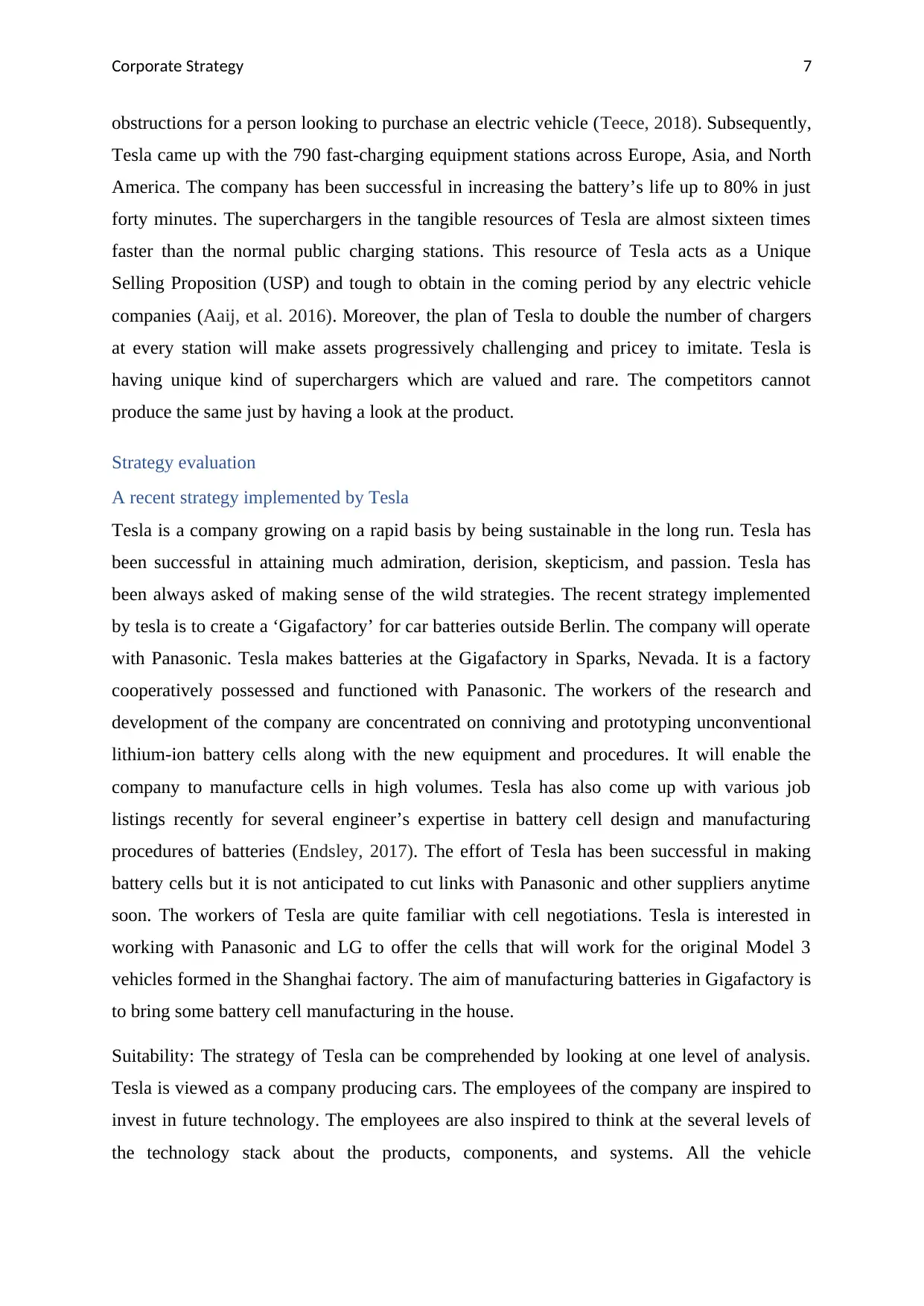
Corporate Strategy 7
obstructions for a person looking to purchase an electric vehicle (Teece, 2018). Subsequently,
Tesla came up with the 790 fast-charging equipment stations across Europe, Asia, and North
America. The company has been successful in increasing the battery’s life up to 80% in just
forty minutes. The superchargers in the tangible resources of Tesla are almost sixteen times
faster than the normal public charging stations. This resource of Tesla acts as a Unique
Selling Proposition (USP) and tough to obtain in the coming period by any electric vehicle
companies (Aaij, et al. 2016). Moreover, the plan of Tesla to double the number of chargers
at every station will make assets progressively challenging and pricey to imitate. Tesla is
having unique kind of superchargers which are valued and rare. The competitors cannot
produce the same just by having a look at the product.
Strategy evaluation
A recent strategy implemented by Tesla
Tesla is a company growing on a rapid basis by being sustainable in the long run. Tesla has
been successful in attaining much admiration, derision, skepticism, and passion. Tesla has
been always asked of making sense of the wild strategies. The recent strategy implemented
by tesla is to create a ‘Gigafactory’ for car batteries outside Berlin. The company will operate
with Panasonic. Tesla makes batteries at the Gigafactory in Sparks, Nevada. It is a factory
cooperatively possessed and functioned with Panasonic. The workers of the research and
development of the company are concentrated on conniving and prototyping unconventional
lithium-ion battery cells along with the new equipment and procedures. It will enable the
company to manufacture cells in high volumes. Tesla has also come up with various job
listings recently for several engineer’s expertise in battery cell design and manufacturing
procedures of batteries (Endsley, 2017). The effort of Tesla has been successful in making
battery cells but it is not anticipated to cut links with Panasonic and other suppliers anytime
soon. The workers of Tesla are quite familiar with cell negotiations. Tesla is interested in
working with Panasonic and LG to offer the cells that will work for the original Model 3
vehicles formed in the Shanghai factory. The aim of manufacturing batteries in Gigafactory is
to bring some battery cell manufacturing in the house.
Suitability: The strategy of Tesla can be comprehended by looking at one level of analysis.
Tesla is viewed as a company producing cars. The employees of the company are inspired to
invest in future technology. The employees are also inspired to think at the several levels of
the technology stack about the products, components, and systems. All the vehicle
obstructions for a person looking to purchase an electric vehicle (Teece, 2018). Subsequently,
Tesla came up with the 790 fast-charging equipment stations across Europe, Asia, and North
America. The company has been successful in increasing the battery’s life up to 80% in just
forty minutes. The superchargers in the tangible resources of Tesla are almost sixteen times
faster than the normal public charging stations. This resource of Tesla acts as a Unique
Selling Proposition (USP) and tough to obtain in the coming period by any electric vehicle
companies (Aaij, et al. 2016). Moreover, the plan of Tesla to double the number of chargers
at every station will make assets progressively challenging and pricey to imitate. Tesla is
having unique kind of superchargers which are valued and rare. The competitors cannot
produce the same just by having a look at the product.
Strategy evaluation
A recent strategy implemented by Tesla
Tesla is a company growing on a rapid basis by being sustainable in the long run. Tesla has
been successful in attaining much admiration, derision, skepticism, and passion. Tesla has
been always asked of making sense of the wild strategies. The recent strategy implemented
by tesla is to create a ‘Gigafactory’ for car batteries outside Berlin. The company will operate
with Panasonic. Tesla makes batteries at the Gigafactory in Sparks, Nevada. It is a factory
cooperatively possessed and functioned with Panasonic. The workers of the research and
development of the company are concentrated on conniving and prototyping unconventional
lithium-ion battery cells along with the new equipment and procedures. It will enable the
company to manufacture cells in high volumes. Tesla has also come up with various job
listings recently for several engineer’s expertise in battery cell design and manufacturing
procedures of batteries (Endsley, 2017). The effort of Tesla has been successful in making
battery cells but it is not anticipated to cut links with Panasonic and other suppliers anytime
soon. The workers of Tesla are quite familiar with cell negotiations. Tesla is interested in
working with Panasonic and LG to offer the cells that will work for the original Model 3
vehicles formed in the Shanghai factory. The aim of manufacturing batteries in Gigafactory is
to bring some battery cell manufacturing in the house.
Suitability: The strategy of Tesla can be comprehended by looking at one level of analysis.
Tesla is viewed as a company producing cars. The employees of the company are inspired to
invest in future technology. The employees are also inspired to think at the several levels of
the technology stack about the products, components, and systems. All the vehicle
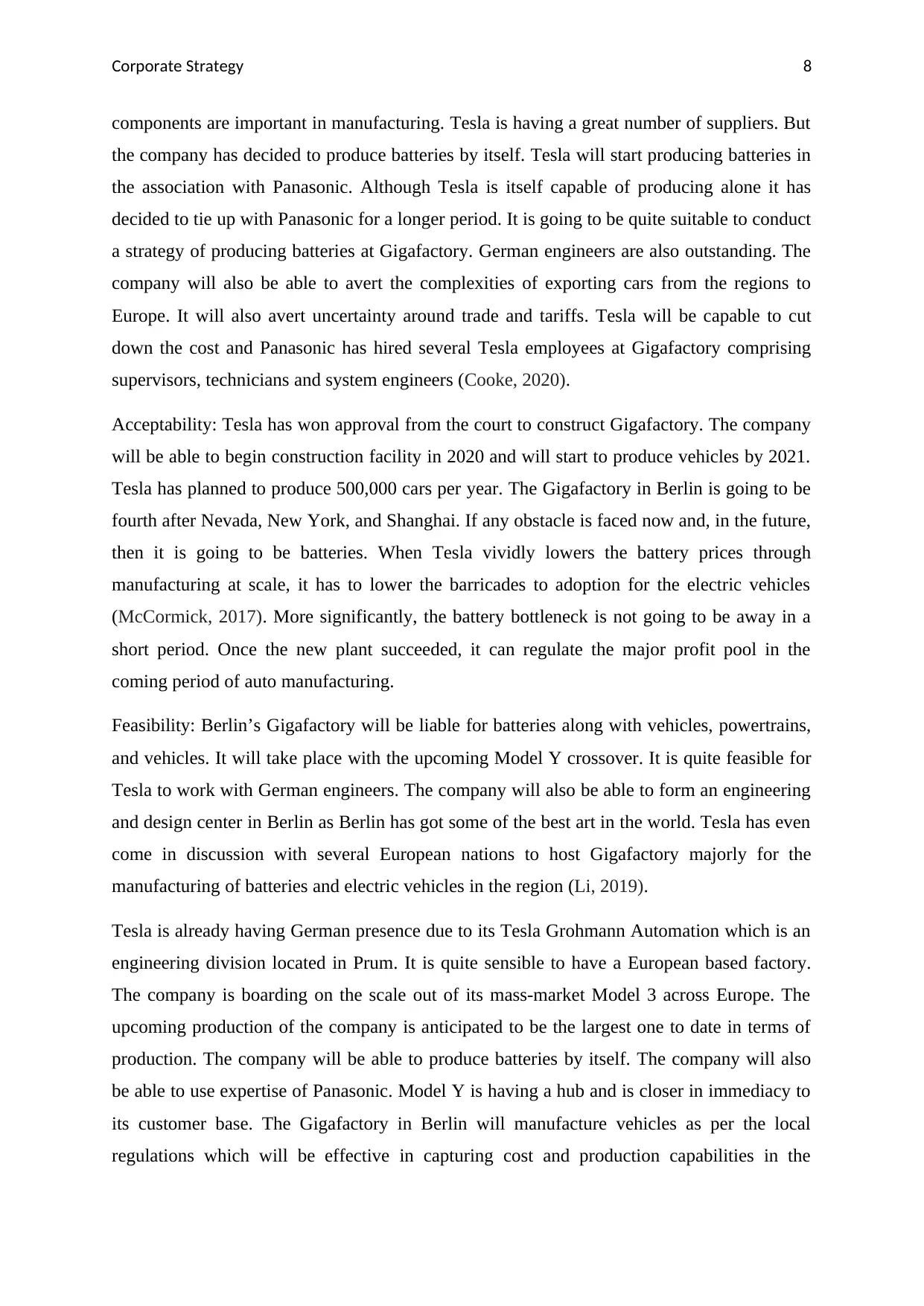
Corporate Strategy 8
components are important in manufacturing. Tesla is having a great number of suppliers. But
the company has decided to produce batteries by itself. Tesla will start producing batteries in
the association with Panasonic. Although Tesla is itself capable of producing alone it has
decided to tie up with Panasonic for a longer period. It is going to be quite suitable to conduct
a strategy of producing batteries at Gigafactory. German engineers are also outstanding. The
company will also be able to avert the complexities of exporting cars from the regions to
Europe. It will also avert uncertainty around trade and tariffs. Tesla will be capable to cut
down the cost and Panasonic has hired several Tesla employees at Gigafactory comprising
supervisors, technicians and system engineers (Cooke, 2020).
Acceptability: Tesla has won approval from the court to construct Gigafactory. The company
will be able to begin construction facility in 2020 and will start to produce vehicles by 2021.
Tesla has planned to produce 500,000 cars per year. The Gigafactory in Berlin is going to be
fourth after Nevada, New York, and Shanghai. If any obstacle is faced now and, in the future,
then it is going to be batteries. When Tesla vividly lowers the battery prices through
manufacturing at scale, it has to lower the barricades to adoption for the electric vehicles
(McCormick, 2017). More significantly, the battery bottleneck is not going to be away in a
short period. Once the new plant succeeded, it can regulate the major profit pool in the
coming period of auto manufacturing.
Feasibility: Berlin’s Gigafactory will be liable for batteries along with vehicles, powertrains,
and vehicles. It will take place with the upcoming Model Y crossover. It is quite feasible for
Tesla to work with German engineers. The company will also be able to form an engineering
and design center in Berlin as Berlin has got some of the best art in the world. Tesla has even
come in discussion with several European nations to host Gigafactory majorly for the
manufacturing of batteries and electric vehicles in the region (Li, 2019).
Tesla is already having German presence due to its Tesla Grohmann Automation which is an
engineering division located in Prum. It is quite sensible to have a European based factory.
The company is boarding on the scale out of its mass-market Model 3 across Europe. The
upcoming production of the company is anticipated to be the largest one to date in terms of
production. The company will be able to produce batteries by itself. The company will also
be able to use expertise of Panasonic. Model Y is having a hub and is closer in immediacy to
its customer base. The Gigafactory in Berlin will manufacture vehicles as per the local
regulations which will be effective in capturing cost and production capabilities in the
components are important in manufacturing. Tesla is having a great number of suppliers. But
the company has decided to produce batteries by itself. Tesla will start producing batteries in
the association with Panasonic. Although Tesla is itself capable of producing alone it has
decided to tie up with Panasonic for a longer period. It is going to be quite suitable to conduct
a strategy of producing batteries at Gigafactory. German engineers are also outstanding. The
company will also be able to avert the complexities of exporting cars from the regions to
Europe. It will also avert uncertainty around trade and tariffs. Tesla will be capable to cut
down the cost and Panasonic has hired several Tesla employees at Gigafactory comprising
supervisors, technicians and system engineers (Cooke, 2020).
Acceptability: Tesla has won approval from the court to construct Gigafactory. The company
will be able to begin construction facility in 2020 and will start to produce vehicles by 2021.
Tesla has planned to produce 500,000 cars per year. The Gigafactory in Berlin is going to be
fourth after Nevada, New York, and Shanghai. If any obstacle is faced now and, in the future,
then it is going to be batteries. When Tesla vividly lowers the battery prices through
manufacturing at scale, it has to lower the barricades to adoption for the electric vehicles
(McCormick, 2017). More significantly, the battery bottleneck is not going to be away in a
short period. Once the new plant succeeded, it can regulate the major profit pool in the
coming period of auto manufacturing.
Feasibility: Berlin’s Gigafactory will be liable for batteries along with vehicles, powertrains,
and vehicles. It will take place with the upcoming Model Y crossover. It is quite feasible for
Tesla to work with German engineers. The company will also be able to form an engineering
and design center in Berlin as Berlin has got some of the best art in the world. Tesla has even
come in discussion with several European nations to host Gigafactory majorly for the
manufacturing of batteries and electric vehicles in the region (Li, 2019).
Tesla is already having German presence due to its Tesla Grohmann Automation which is an
engineering division located in Prum. It is quite sensible to have a European based factory.
The company is boarding on the scale out of its mass-market Model 3 across Europe. The
upcoming production of the company is anticipated to be the largest one to date in terms of
production. The company will be able to produce batteries by itself. The company will also
be able to use expertise of Panasonic. Model Y is having a hub and is closer in immediacy to
its customer base. The Gigafactory in Berlin will manufacture vehicles as per the local
regulations which will be effective in capturing cost and production capabilities in the
⊘ This is a preview!⊘
Do you want full access?
Subscribe today to unlock all pages.

Trusted by 1+ million students worldwide
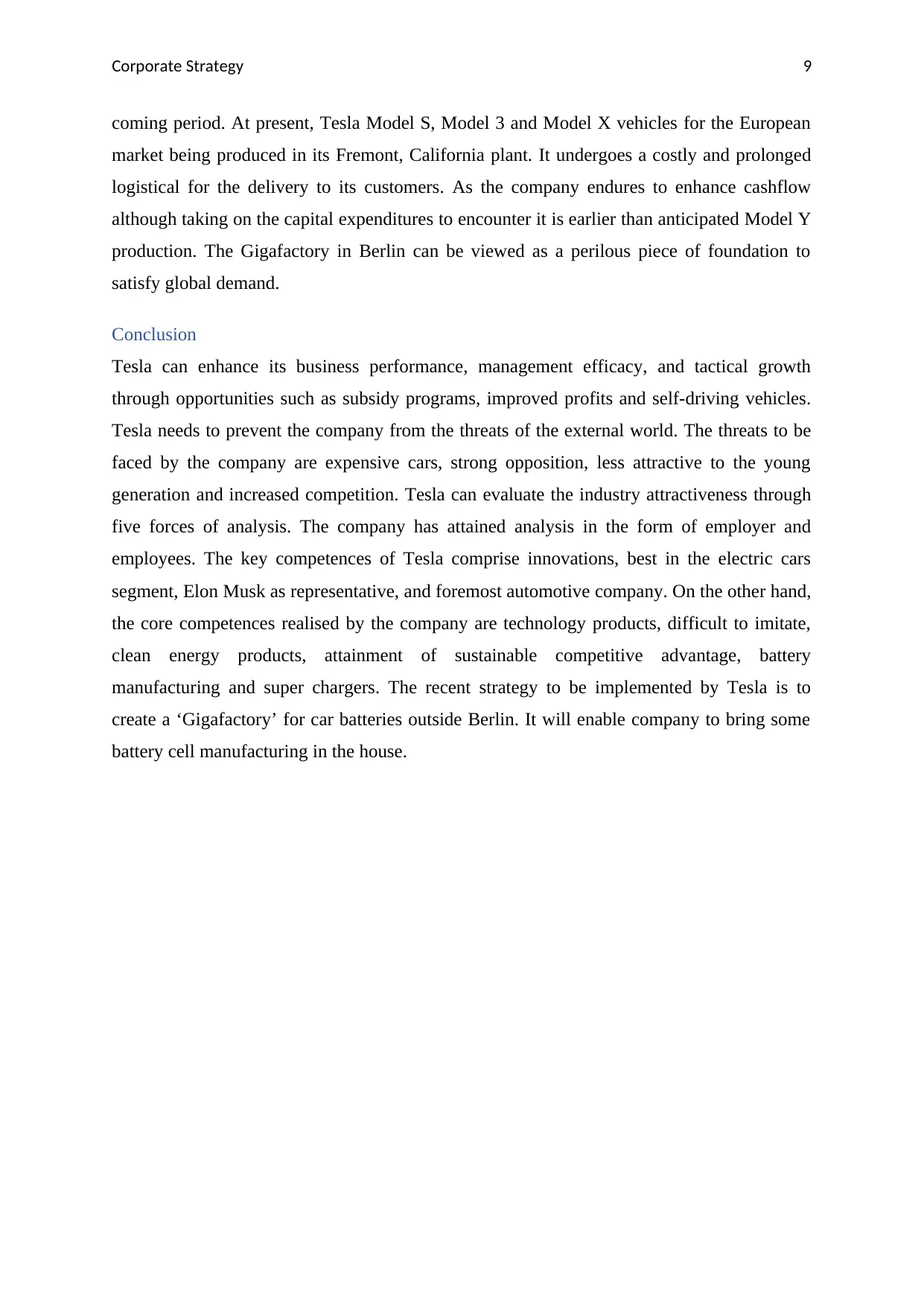
Corporate Strategy 9
coming period. At present, Tesla Model S, Model 3 and Model X vehicles for the European
market being produced in its Fremont, California plant. It undergoes a costly and prolonged
logistical for the delivery to its customers. As the company endures to enhance cashflow
although taking on the capital expenditures to encounter it is earlier than anticipated Model Y
production. The Gigafactory in Berlin can be viewed as a perilous piece of foundation to
satisfy global demand.
Conclusion
Tesla can enhance its business performance, management efficacy, and tactical growth
through opportunities such as subsidy programs, improved profits and self-driving vehicles.
Tesla needs to prevent the company from the threats of the external world. The threats to be
faced by the company are expensive cars, strong opposition, less attractive to the young
generation and increased competition. Tesla can evaluate the industry attractiveness through
five forces of analysis. The company has attained analysis in the form of employer and
employees. The key competences of Tesla comprise innovations, best in the electric cars
segment, Elon Musk as representative, and foremost automotive company. On the other hand,
the core competences realised by the company are technology products, difficult to imitate,
clean energy products, attainment of sustainable competitive advantage, battery
manufacturing and super chargers. The recent strategy to be implemented by Tesla is to
create a ‘Gigafactory’ for car batteries outside Berlin. It will enable company to bring some
battery cell manufacturing in the house.
coming period. At present, Tesla Model S, Model 3 and Model X vehicles for the European
market being produced in its Fremont, California plant. It undergoes a costly and prolonged
logistical for the delivery to its customers. As the company endures to enhance cashflow
although taking on the capital expenditures to encounter it is earlier than anticipated Model Y
production. The Gigafactory in Berlin can be viewed as a perilous piece of foundation to
satisfy global demand.
Conclusion
Tesla can enhance its business performance, management efficacy, and tactical growth
through opportunities such as subsidy programs, improved profits and self-driving vehicles.
Tesla needs to prevent the company from the threats of the external world. The threats to be
faced by the company are expensive cars, strong opposition, less attractive to the young
generation and increased competition. Tesla can evaluate the industry attractiveness through
five forces of analysis. The company has attained analysis in the form of employer and
employees. The key competences of Tesla comprise innovations, best in the electric cars
segment, Elon Musk as representative, and foremost automotive company. On the other hand,
the core competences realised by the company are technology products, difficult to imitate,
clean energy products, attainment of sustainable competitive advantage, battery
manufacturing and super chargers. The recent strategy to be implemented by Tesla is to
create a ‘Gigafactory’ for car batteries outside Berlin. It will enable company to bring some
battery cell manufacturing in the house.
Paraphrase This Document
Need a fresh take? Get an instant paraphrase of this document with our AI Paraphraser
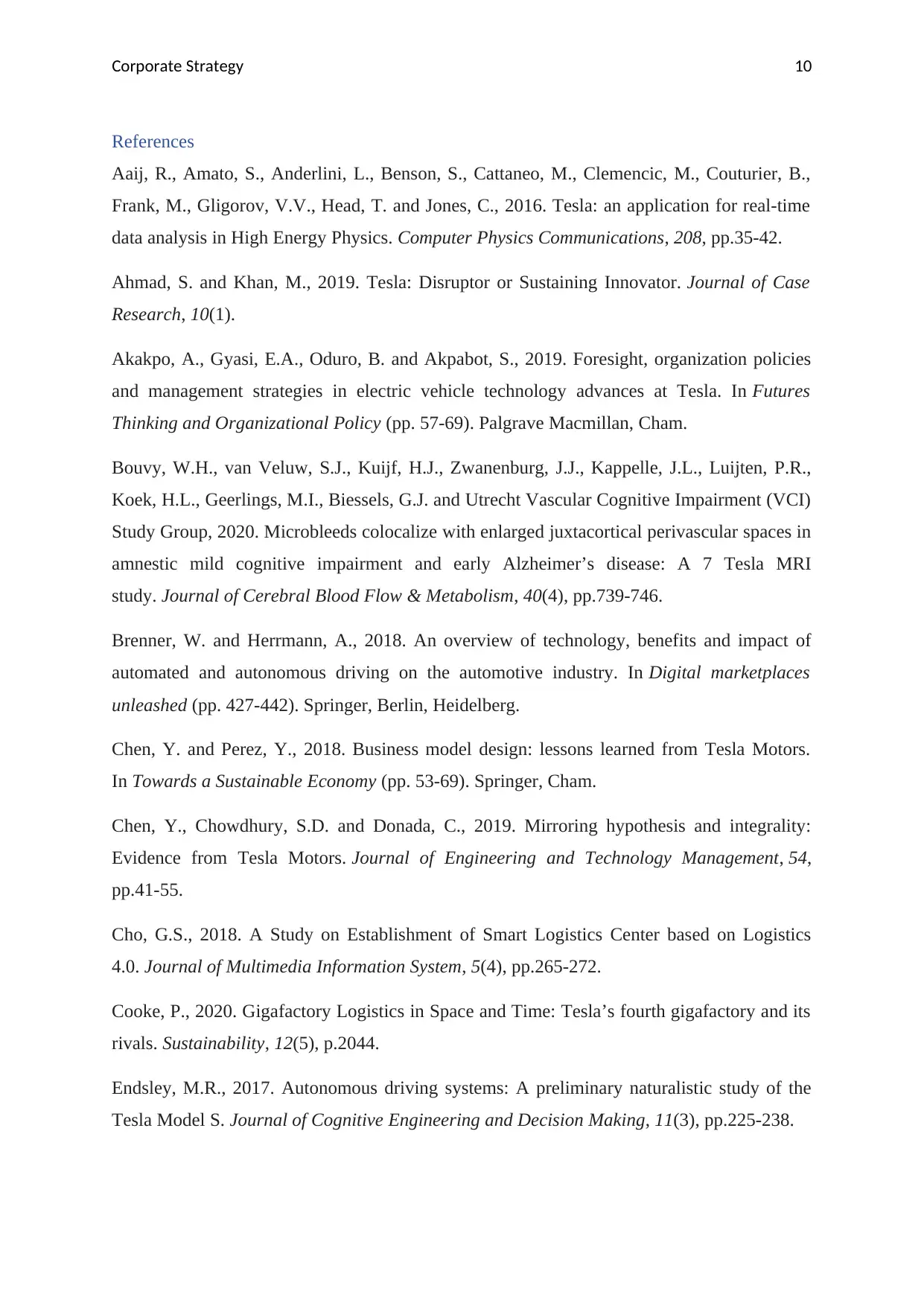
Corporate Strategy 10
References
Aaij, R., Amato, S., Anderlini, L., Benson, S., Cattaneo, M., Clemencic, M., Couturier, B.,
Frank, M., Gligorov, V.V., Head, T. and Jones, C., 2016. Tesla: an application for real-time
data analysis in High Energy Physics. Computer Physics Communications, 208, pp.35-42.
Ahmad, S. and Khan, M., 2019. Tesla: Disruptor or Sustaining Innovator. Journal of Case
Research, 10(1).
Akakpo, A., Gyasi, E.A., Oduro, B. and Akpabot, S., 2019. Foresight, organization policies
and management strategies in electric vehicle technology advances at Tesla. In Futures
Thinking and Organizational Policy (pp. 57-69). Palgrave Macmillan, Cham.
Bouvy, W.H., van Veluw, S.J., Kuijf, H.J., Zwanenburg, J.J., Kappelle, J.L., Luijten, P.R.,
Koek, H.L., Geerlings, M.I., Biessels, G.J. and Utrecht Vascular Cognitive Impairment (VCI)
Study Group, 2020. Microbleeds colocalize with enlarged juxtacortical perivascular spaces in
amnestic mild cognitive impairment and early Alzheimer’s disease: A 7 Tesla MRI
study. Journal of Cerebral Blood Flow & Metabolism, 40(4), pp.739-746.
Brenner, W. and Herrmann, A., 2018. An overview of technology, benefits and impact of
automated and autonomous driving on the automotive industry. In Digital marketplaces
unleashed (pp. 427-442). Springer, Berlin, Heidelberg.
Chen, Y. and Perez, Y., 2018. Business model design: lessons learned from Tesla Motors.
In Towards a Sustainable Economy (pp. 53-69). Springer, Cham.
Chen, Y., Chowdhury, S.D. and Donada, C., 2019. Mirroring hypothesis and integrality:
Evidence from Tesla Motors. Journal of Engineering and Technology Management, 54,
pp.41-55.
Cho, G.S., 2018. A Study on Establishment of Smart Logistics Center based on Logistics
4.0. Journal of Multimedia Information System, 5(4), pp.265-272.
Cooke, P., 2020. Gigafactory Logistics in Space and Time: Tesla’s fourth gigafactory and its
rivals. Sustainability, 12(5), p.2044.
Endsley, M.R., 2017. Autonomous driving systems: A preliminary naturalistic study of the
Tesla Model S. Journal of Cognitive Engineering and Decision Making, 11(3), pp.225-238.
References
Aaij, R., Amato, S., Anderlini, L., Benson, S., Cattaneo, M., Clemencic, M., Couturier, B.,
Frank, M., Gligorov, V.V., Head, T. and Jones, C., 2016. Tesla: an application for real-time
data analysis in High Energy Physics. Computer Physics Communications, 208, pp.35-42.
Ahmad, S. and Khan, M., 2019. Tesla: Disruptor or Sustaining Innovator. Journal of Case
Research, 10(1).
Akakpo, A., Gyasi, E.A., Oduro, B. and Akpabot, S., 2019. Foresight, organization policies
and management strategies in electric vehicle technology advances at Tesla. In Futures
Thinking and Organizational Policy (pp. 57-69). Palgrave Macmillan, Cham.
Bouvy, W.H., van Veluw, S.J., Kuijf, H.J., Zwanenburg, J.J., Kappelle, J.L., Luijten, P.R.,
Koek, H.L., Geerlings, M.I., Biessels, G.J. and Utrecht Vascular Cognitive Impairment (VCI)
Study Group, 2020. Microbleeds colocalize with enlarged juxtacortical perivascular spaces in
amnestic mild cognitive impairment and early Alzheimer’s disease: A 7 Tesla MRI
study. Journal of Cerebral Blood Flow & Metabolism, 40(4), pp.739-746.
Brenner, W. and Herrmann, A., 2018. An overview of technology, benefits and impact of
automated and autonomous driving on the automotive industry. In Digital marketplaces
unleashed (pp. 427-442). Springer, Berlin, Heidelberg.
Chen, Y. and Perez, Y., 2018. Business model design: lessons learned from Tesla Motors.
In Towards a Sustainable Economy (pp. 53-69). Springer, Cham.
Chen, Y., Chowdhury, S.D. and Donada, C., 2019. Mirroring hypothesis and integrality:
Evidence from Tesla Motors. Journal of Engineering and Technology Management, 54,
pp.41-55.
Cho, G.S., 2018. A Study on Establishment of Smart Logistics Center based on Logistics
4.0. Journal of Multimedia Information System, 5(4), pp.265-272.
Cooke, P., 2020. Gigafactory Logistics in Space and Time: Tesla’s fourth gigafactory and its
rivals. Sustainability, 12(5), p.2044.
Endsley, M.R., 2017. Autonomous driving systems: A preliminary naturalistic study of the
Tesla Model S. Journal of Cognitive Engineering and Decision Making, 11(3), pp.225-238.
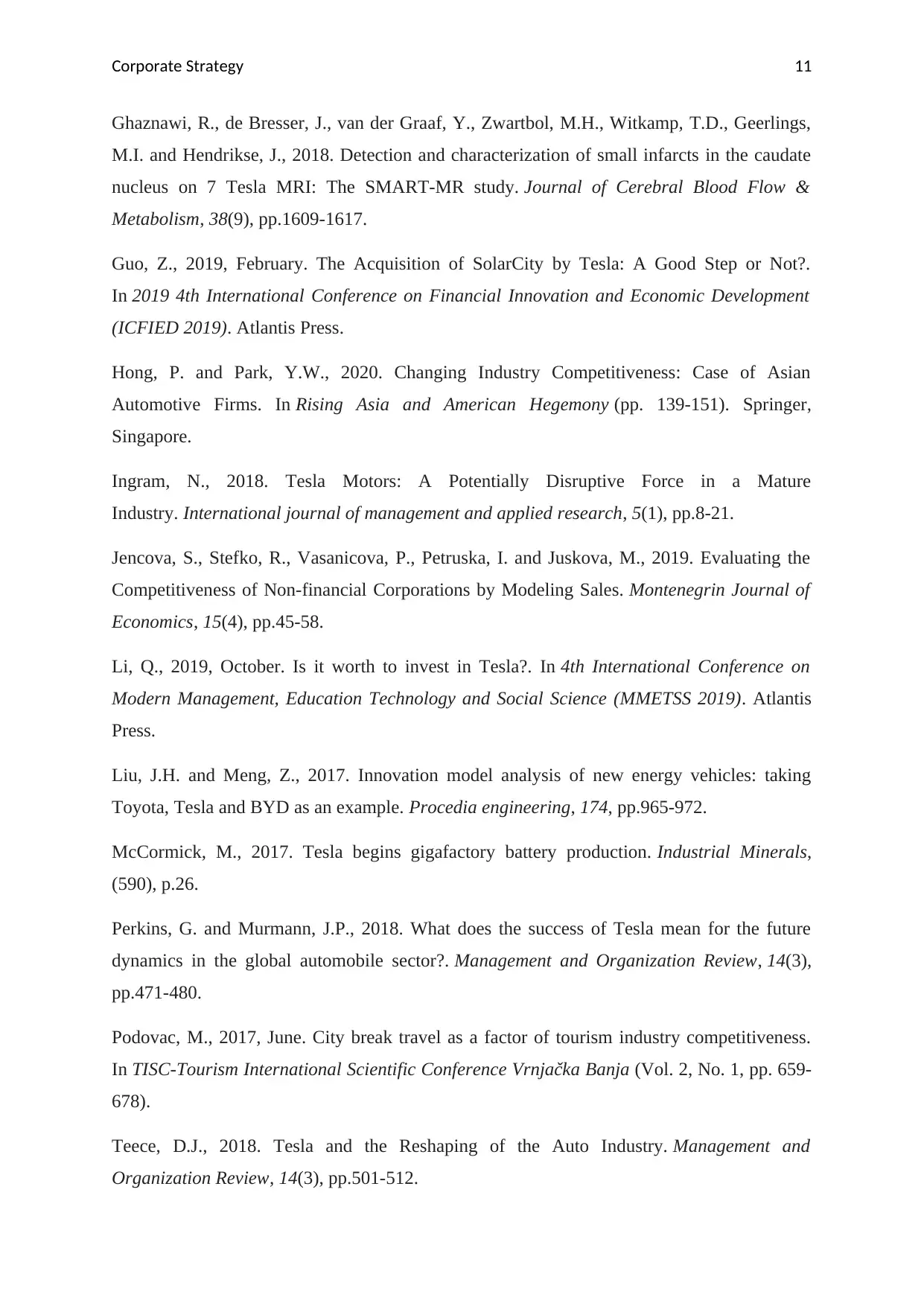
Corporate Strategy 11
Ghaznawi, R., de Bresser, J., van der Graaf, Y., Zwartbol, M.H., Witkamp, T.D., Geerlings,
M.I. and Hendrikse, J., 2018. Detection and characterization of small infarcts in the caudate
nucleus on 7 Tesla MRI: The SMART-MR study. Journal of Cerebral Blood Flow &
Metabolism, 38(9), pp.1609-1617.
Guo, Z., 2019, February. The Acquisition of SolarCity by Tesla: A Good Step or Not?.
In 2019 4th International Conference on Financial Innovation and Economic Development
(ICFIED 2019). Atlantis Press.
Hong, P. and Park, Y.W., 2020. Changing Industry Competitiveness: Case of Asian
Automotive Firms. In Rising Asia and American Hegemony (pp. 139-151). Springer,
Singapore.
Ingram, N., 2018. Tesla Motors: A Potentially Disruptive Force in a Mature
Industry. International journal of management and applied research, 5(1), pp.8-21.
Jencova, S., Stefko, R., Vasanicova, P., Petruska, I. and Juskova, M., 2019. Evaluating the
Competitiveness of Non-financial Corporations by Modeling Sales. Montenegrin Journal of
Economics, 15(4), pp.45-58.
Li, Q., 2019, October. Is it worth to invest in Tesla?. In 4th International Conference on
Modern Management, Education Technology and Social Science (MMETSS 2019). Atlantis
Press.
Liu, J.H. and Meng, Z., 2017. Innovation model analysis of new energy vehicles: taking
Toyota, Tesla and BYD as an example. Procedia engineering, 174, pp.965-972.
McCormick, M., 2017. Tesla begins gigafactory battery production. Industrial Minerals,
(590), p.26.
Perkins, G. and Murmann, J.P., 2018. What does the success of Tesla mean for the future
dynamics in the global automobile sector?. Management and Organization Review, 14(3),
pp.471-480.
Podovac, M., 2017, June. City break travel as a factor of tourism industry competitiveness.
In TISC-Tourism International Scientific Conference Vrnjačka Banja (Vol. 2, No. 1, pp. 659-
678).
Teece, D.J., 2018. Tesla and the Reshaping of the Auto Industry. Management and
Organization Review, 14(3), pp.501-512.
Ghaznawi, R., de Bresser, J., van der Graaf, Y., Zwartbol, M.H., Witkamp, T.D., Geerlings,
M.I. and Hendrikse, J., 2018. Detection and characterization of small infarcts in the caudate
nucleus on 7 Tesla MRI: The SMART-MR study. Journal of Cerebral Blood Flow &
Metabolism, 38(9), pp.1609-1617.
Guo, Z., 2019, February. The Acquisition of SolarCity by Tesla: A Good Step or Not?.
In 2019 4th International Conference on Financial Innovation and Economic Development
(ICFIED 2019). Atlantis Press.
Hong, P. and Park, Y.W., 2020. Changing Industry Competitiveness: Case of Asian
Automotive Firms. In Rising Asia and American Hegemony (pp. 139-151). Springer,
Singapore.
Ingram, N., 2018. Tesla Motors: A Potentially Disruptive Force in a Mature
Industry. International journal of management and applied research, 5(1), pp.8-21.
Jencova, S., Stefko, R., Vasanicova, P., Petruska, I. and Juskova, M., 2019. Evaluating the
Competitiveness of Non-financial Corporations by Modeling Sales. Montenegrin Journal of
Economics, 15(4), pp.45-58.
Li, Q., 2019, October. Is it worth to invest in Tesla?. In 4th International Conference on
Modern Management, Education Technology and Social Science (MMETSS 2019). Atlantis
Press.
Liu, J.H. and Meng, Z., 2017. Innovation model analysis of new energy vehicles: taking
Toyota, Tesla and BYD as an example. Procedia engineering, 174, pp.965-972.
McCormick, M., 2017. Tesla begins gigafactory battery production. Industrial Minerals,
(590), p.26.
Perkins, G. and Murmann, J.P., 2018. What does the success of Tesla mean for the future
dynamics in the global automobile sector?. Management and Organization Review, 14(3),
pp.471-480.
Podovac, M., 2017, June. City break travel as a factor of tourism industry competitiveness.
In TISC-Tourism International Scientific Conference Vrnjačka Banja (Vol. 2, No. 1, pp. 659-
678).
Teece, D.J., 2018. Tesla and the Reshaping of the Auto Industry. Management and
Organization Review, 14(3), pp.501-512.
⊘ This is a preview!⊘
Do you want full access?
Subscribe today to unlock all pages.

Trusted by 1+ million students worldwide
1 out of 13
Related Documents
Your All-in-One AI-Powered Toolkit for Academic Success.
+13062052269
info@desklib.com
Available 24*7 on WhatsApp / Email
![[object Object]](/_next/static/media/star-bottom.7253800d.svg)
Unlock your academic potential
Copyright © 2020–2025 A2Z Services. All Rights Reserved. Developed and managed by ZUCOL.





